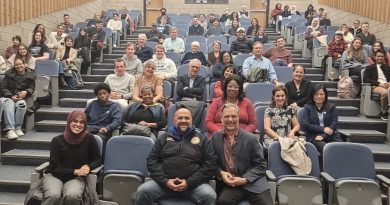Visiting Scholar Luck Discusses R2P in the Modern Age
By Madison McHugh
Associate Editor
UNA-SHU, Seton Hall’s chapter of the United Nations Association of the United States of America (UNA-USA), and the Center for United Nations and Global Governance Studies hosted a lecture and discussion on March 30 featuring former UN Secretary-General’s Special Advisor Edward C. Luck, who has recently been named the Tom and Ruth Sharkey Distinguished Visiting Scholar.
The lecture, “Nurturing a Norm: Learning from the UN’s Responsibility to Protect (R2P) Experience,” addressed the history and progression of R2P as a new concept turned popular policy. Luck claimed that there is much to talk about surrounding the history of the UN and R2P, but shortened his time to discuss the “normative experience and birthing pains while trying to reach a mature stage.”
Luck began his lecture by saying, “Mass murder is a familiar characteristic of the 21st century,” naming countless examples in the Middle East, Africa and more. His approach to the issue of R2P stems from a belief that, “Sovereignty cannot be a cloak to international response to this kind of killing,” referencing the UN’s prior guilt for failures concerning past genocides.
He also addressed how timing and previous legislature initially prevented the concept of R2P when it was first brought before the UN. The first report referencing R2P was supposed to come out a week before the 9/11 attacks. However, it was delayed until after the event, which resulted in “bad timing” for the concept. Additionally, the specification on the use of force as a “last resort” went directly against existing UN legislation.
The issue was raised again at the World Summit in 2005 where former Secretary-General Kofi Annan pushed for R2P, and eventually all member states became “firmly committed to protecting populations by preventing genocide, war crimes, and crimes against humanity.”
In reference to norm development thereafter, Luck said, “Norms evolve in a pattern life cycle in three stages – norm emergence, cascade, and internalization… While the theory was great, the reality was something different.”
Luck launched into an explanation of the three pillars of R2P: protect all populations in a territory, assist states in fulfilment of protection, and respond by use of diplomatic, humanitarian, and other means to prevent crimes. Luck also explained how there were some states who wished to address one or two pillars, stating, “These are not stops on a subway station; they are parallel and at the same time.”
Luck finished his lecture with a reflection on how to address R2P in today’s world. When asked how to identify if a situation calls for R2P, he said it must fit the four crimes enlisted in the UN Charter and “not an inch beyond.” He admits many setbacks, but still has hope for development in the years to come. “We’ve failed spectacularly in some cases, but things are still moving forward,” he said.


